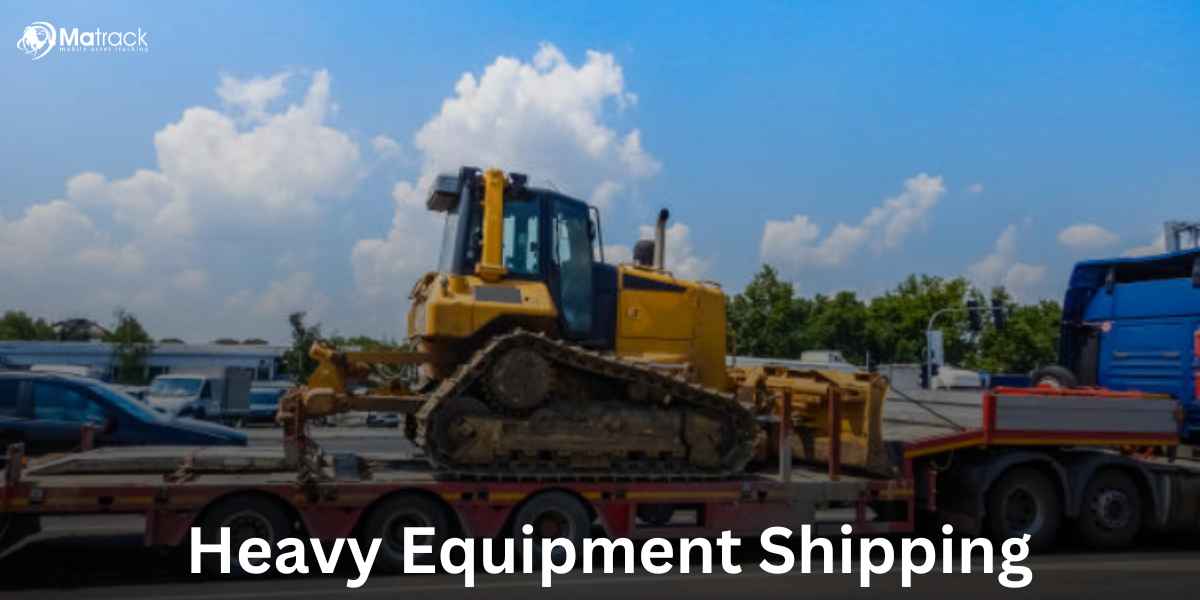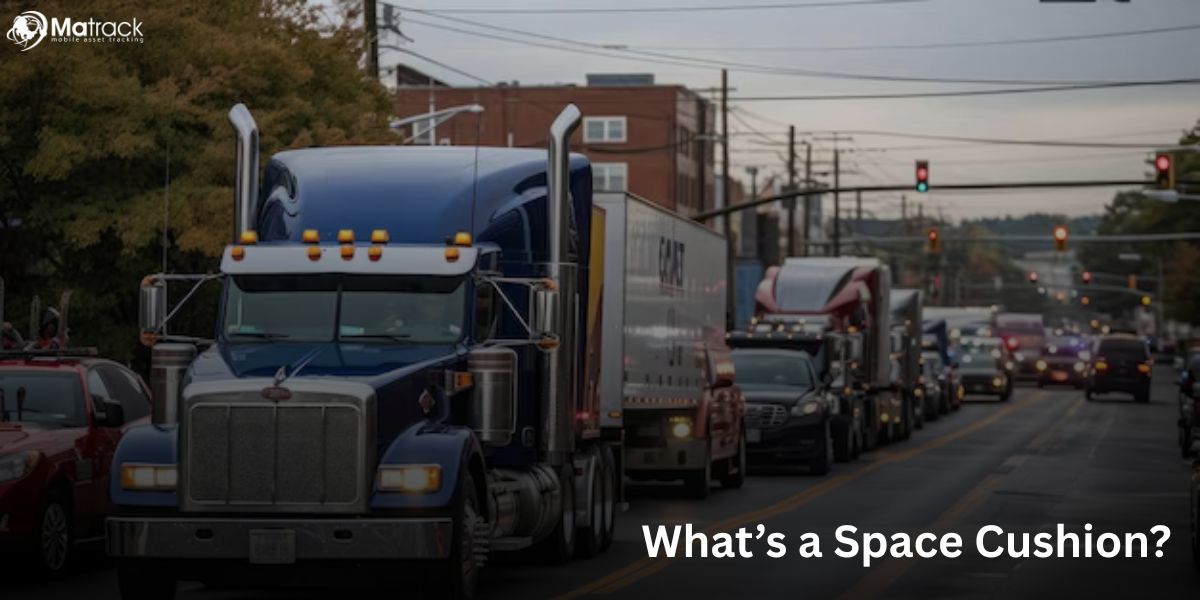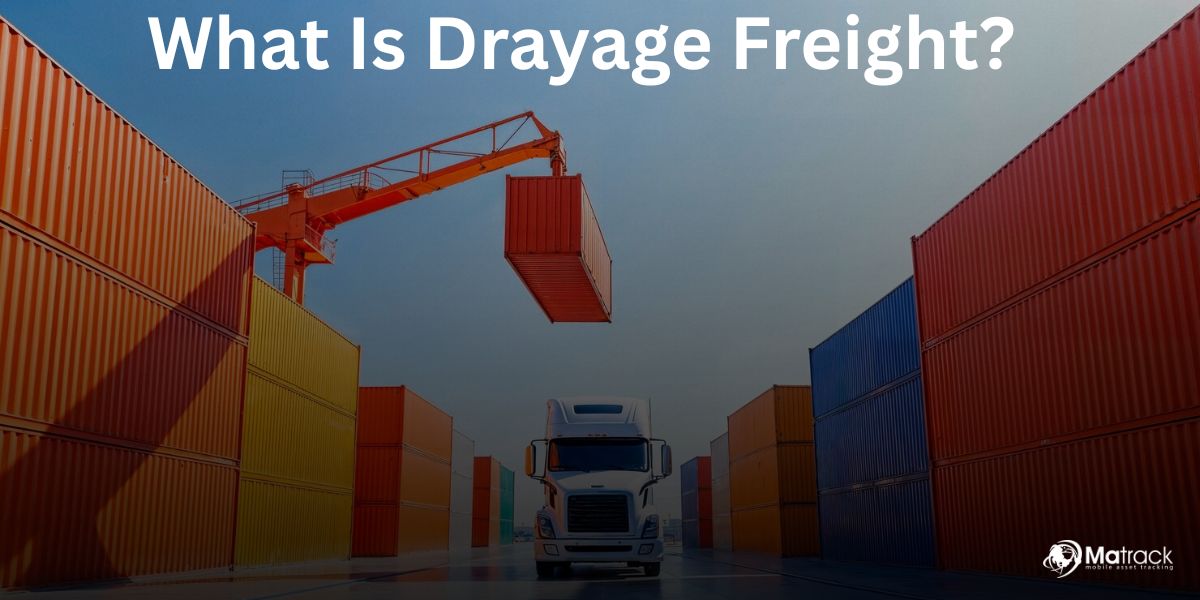Key Takeaways:
- Heavy equipment shipping requires the right trailer, legal permits, and secure loading to avoid damage or delays.
- Equipment must be cleaned, inspected, and prepared properly before transport to meet safety and compliance standards.
- Costs vary by equipment type, route, and services like escorts or permits, and insurance is required for risk protection.
- Choosing a reliable carrier and using GPS tracking like Matrack improves delivery control, safety, and fleet efficiency.
What is Heavy Equipment Shipping?
Heavy equipment shipping involves transporting large industrial machines that exceed standard size and weight limits. These machines include excavators, graders, and compactors.
The trailer selection, permit requirements, and load security methods vary depending on the type of equipment. Any mismatch in these areas can cause legal issues or transport failures.
Transporting this kind of equipment always includes risks such as road accidents, mechanical damage, or shipment delays. These risks make it essential to rely on professionals who understand how to manage heavy equipment shipping safely and legally.
Why Heavy Equipment Shipping Requires Expert Handling?
Oversized Dimensions
Excavators and dozers often exceed the legal limits for transport on public roads. Their height, width, and weight regularly surpass 13.5 feet, 8.5 feet, and 80,000 pounds.
High Cargo Value
A single Caterpillar excavator can cost between $150,000 and $750,000. Transporting such high-value equipment demands accuracy in loading and transit.
Permit Requirements
Every oversized load must have a DOT Oversize Load Permit. Permits vary by state and international region and must be secured before transport begins.
Safety Risks
Heavy equipment with improper weight distribution increases braking distance. It raises the risk of rollovers, especially during turns or emergency stops.
Special Equipment
Standard trailers cannot carry equipment that exceeds height or axle limits. Lowboys, RGN trailers, and dual-lane extendables are used based on machine shape and weight.
Trailer selection depends on the equipment’s size and transport requirements, which defines the next step in heavy equipment shipping.
Types of Heavy Equipment Transport Trailers
Trailer selection depends on the equipment’s size, weight, and loading method. Each trailer type fits specific machinery and road safety regulations.
Flatbed Trailers
Flatbeds trailers equipment under 8.5 feet in height and up to 48,000 pounds. Skid steers, small tractors, and compact excavators use this type.
Step Deck Trailers
Step decks include a lowered section to fit taller machines. Backhoes and forklifts under 10 feet fit this configuration.
Lowboy Trailers
Lowboys support equipment up to 12 feet tall and distribute heavy loads evenly. Graders, loaders, and medium bulldozers move on lowboys.
RGN Trailers
RGNs detach at the front to allow machines to roll on. Equipment that cannot be lifted uses this option.
Double Drop Trailers
Double drops have a lowered center to fit machines up to 11.5 feet tall. Crushers and industrial HVAC systems are common loads.
Extendable Trailers
Extendables adjust in length to handle oversized loads. Windmill blades, pipelines, and conveyors are transported on these trailers.
Trailer compatibility depends on equipment dimensions and transport constraints. The next step is preparing the equipment correctly before loading.
How to Prepare Heavy Equipment for Shipping
Preparation ensures that equipment moves safely, stays within legal limits, and avoids damage in transit. Each step aligns with carrier requirements and transport regulations.
Clean All Surfaces
Remove all soil, grease, and oil from exposed surfaces. Clean equipment passes inspection and prevents cross-border contamination.
Document Equipment Condition
Photograph the machine from multiple angles using 10 to 20 high-resolution images. These records verify the equipment’s condition before loading.
Check and Drain Fluids
Inspect hydraulic, fuel, and coolant levels. Drain or adjust fluids as specified by the transport carrier.
Disassemble Attachments
Detach boom arms, buckets, and blades when overall dimensions exceed trailer space. Pack and secure these parts separately.
Secure Loose Components
Fasten mirrors, control levers, panels, and glass features. This prevents vibration-related damage during transport.
Disconnect the Battery
Disconnect all power sources before loading. This prevents short circuits and eliminates spark hazards.
Equipment that’s properly prepared is ready for secure and compliant loading, which begins with applying the correct tie-down procedures on the trailer.
How to Secure Heavy Equipment on a Trailer?
Load securement prevents shifting, equipment damage, and road hazards. All procedures must meet FMCSA standards defined in 49 CFR Part 393.130.
Use Grade 70 Transport Chains
Use one chain for every 10,000 pounds of equipment weight. A 40,000-pound loader requires four chains for legal and safe tie-down.
Install Edge Protectors
Place guards on corners where chains or straps contact the equipment. This prevents friction damage and maintains strap integrity.
Apply Direct Tie-Downs
Connect both the front and rear of the machine directly to the trailer. Use D-rings or welded anchor points for secure fastening.
Use Wooden Blocks and Dunnage
Place wood blocks or dunnage under the frame to prevent rolling. This stabilizes the equipment under sharp turns or sudden stops.
Check and Re-tighten After 50 Miles
Stop after the first 50 miles to inspect and retighten all tie-downs. Trailer vibration often loosens chains and must be corrected early.
Use a Telematics System for Monitoring
Equip the trailer with a telematics system to track load stability and equipment status in real time. These systems send alerts for vibration, shock events, and sudden movement during transit.
Each securement step reduces the risk of equipment failure and transport violation. Transport limitations set by state and federal laws impose additional control on load dimensions and routing.
Transport Permits and Route Limitations for Heavy Equipment Shipping
Shipping heavy equipment across state lines requires specific permits and careful route planning. Every shipment must comply with legal thresholds for size, weight, and movement through public roads.
Oversize Load Permits
Permits are required when machinery exceeds 8.5 feet in width, 13.5 feet in height, or 53 feet in length. These clear legal access to highways that support larger dimensions.
Overweight Load Permits
Any equipment that pushes the total vehicle weight above 80,000 pounds must have an overweight permit. These permits are based on axle load distribution and surface impact.
Superload Permits
Superloads go beyond standard thresholds and need permits when cargo reaches over 16 feet in width or 150,000 pounds in weight. These shipments often need pre-approved routes and clearance from multiple departments.
Pilot Car and Escort Permits
Escort vehicles are mandatory in most states once a shipment passes 12 feet in width or 90 feet in length. They guide the transport safely through traffic and complex intersections.
Route Survey Requirements
In city zones, bridges, tight corners, and construction areas may create clearance problems. Route surveys verify safe passage before permits are issued.
Primary Interstate Routes for Heavy Equipment
Most heavy shipments use major corridors that support wide loads:
- I-10 and I-40 link Texas and Louisiana with the West Coast.
- I-70 and I-80 move equipment between the Midwest and East Coast.
- I-5 and I-95 serve northern and southern coastal machinery flows.
State Transport Limitations
Some states enforce stricter rules. New York limits transport during rush hours. California applies tighter axle laws than Texas, requiring adjusted trailer setups.
Legal permits and route awareness form the foundation of any safe and compliant equipment shipment.
Heavy Equipment Shipping Costs
Shipping costs depend on equipment type, distance, route complexity, and weight class:
| Equipment Type | Average Cost per Mile | Example Load |
| Skid Steer | $2.50 | 8,000 lbs |
| Excavator | $3.50 | 45,000 lbs |
| Crawler Dozer | $5.00 | 80,000+ lbs |
Additional Cost Factors in Heavy Equipment Shipping
Heavy equipment shipping includes extra charges beyond base transport rates. These depend on equipment type, route length, and legal requirements:
- Fuel Surcharge: 15%–20% of base cost due to fluctuating diesel rates
- Permit Fees: $100 to $1,000 per route, per state
- Escort Vehicles: $1.75 to $2.50 per mile for one escort, double for two
- Tolls and Route Fees: Bridges and tunnels may charge $100–$500 extra
Each charge directly increases total cost and must be included in every shipment estimate. After confirming the full pricing structure, securing proper insurance is necessary for financial protection and legal compliance.
What Insurance is Needed for Heavy Equipment Shipping?
Heavy equipment transport must be insured against loss, damage, or liability. Each policy type covers different risks:
- Cargo Insurance: Covers equipment damage during transit; typical limits range from $100,000 to $1,000,000
- General Liability Insurance: Covers injury or property damage caused during the shipment
- Inland Marine Insurance: Applies to movable equipment shipped within national borders
- Declared Value: Ensures full-value reimbursement in case of total loss
Always verify the Certificate of Insurance (COI) from the carrier before booking. Coverage terms must match the value and nature of the equipment. Carrier selection plays a direct role in risk control and service quality.
How to Choose a Reliable Heavy Equipment Shipping Company?
Choosing the right shipping company determines the safety, legality, and efficiency of equipment transport. Evaluate each carrier using specific, verifiable criteria to avoid delays, damage, or non-compliance.
Verify USDOT and MC Numbers
Check if the carrier holds valid and active registration with the Department of Transportation. Use the FMCSA SAFER database to confirm both USDOT and MC authority status.
Review Insurance Certificate
Request the carrier’s Certificate of Insurance. Confirm that the coverage amount equals or exceeds the total value of the equipment being shipped.
Check Equipment Capability
Inspect whether the carrier owns or has access to the necessary trailers. Confirm capacity, trailer types, and readiness to match the equipment’s dimensions and weight.
Ask for References
Contact at least three recent clients. Review their experiences regarding delivery time, load capacity, and communication quality.
Evaluate Permitting Knowledge
Ensure the company manages all necessary permits and escort arrangements. Verify their understanding of oversize, overweight, and superload requirements.
Check Tracking and Communication
Choose a carrier that offers real-time tracking for every shipment. 24/7 communication access is essential for handling delays or route changes.
Optimize Heavy Equipment Shipping with Matrack Fleet Tracking
Matrack GPS fleet tracking gives real-time updates on vehicle location, engine status, and driver behavior. It helps shippers respond quickly to issues like towing, speed violations, or low battery alerts.
Fleet managers can monitor equipment 24/7 to avoid delays and reduce downtime. The system tracks diagnostics, fuel use, and provides accurate ETAs for every shipment.
Geofence alerts notify users when vehicles enter or leave specific areas. All features are available through a simple dashboard on desktop and mobile devices, making it easy to manage heavy equipment shipping from anywhere.



